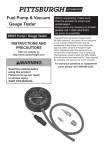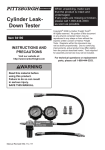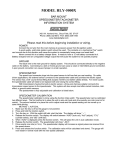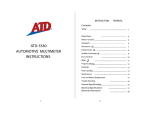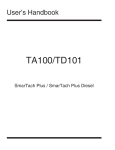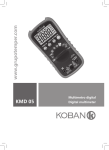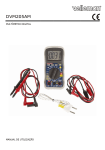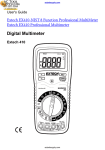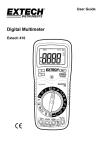Download Harbor Freight Tools LCD Automotive Multimeter with Tachometer Kit Product manual
Transcript
3-1/2 Digit LCD Multimeter with Tachometer Kit Item 95670 Instructions and precautions Visit our website at: http://www.harborfreight.com Read this material before using this product. Failure to do so can result in serious injury. Save this manual. When unpacking, make sure that the product is intact and undamaged. If any parts are missing or broken, please call 1‑800‑444‑3353 as soon as possible. Copyright© 2008 by Harbor Freight Tools®. All rights reserved. No portion of this document or any artwork contained herein may be reproduced in any shape or form without the express written consent of Harbor Freight Tools. Diagrams within this document may not be drawn proportionally. Due to continuing improvements, actual product may differ slightly from the product described herein. Tools required for assembly and service may not be included. For technical questions or replacement parts, please call 1‑800‑444‑3353. Email our technical support at: [email protected] Manual Revised 11h Specifications Electrical Requirements Fuse Display V~ Testing Frequency Accuracy One 9V battery F250mA L 250V LCD 3.5 digits (to 1999) 45 to 450 Hz See individual test operating sections Save This Manual Keep this manual for the safety warnings and precautions, assembly, operating, inspection, maintenance and cleaning procedures. Write the product’s serial number in the back of the manual near the assembly diagram (or month and year of purchase if product has no number). Keep this manual and the receipt in a safe and dry place for future reference. Important Safety Information In this manual, on the labeling, and all other information provided with this product: This is the safety alert symbol. It is used to alert you to potential personal injury hazards. Obey all safety messages that follow this symbol to avoid possible injury or death. DANGER indicates a hazardous situation which, if not avoided, will result in death or serious injury. CAUTION, used with the safety alert symbol, indicates a hazardous situation which, if not avoided, could result in minor or moderate injury. NOTICE is used to address practices not related to personal injury. CAUTION, without the safety alert symbol, is used to address practices not related to personal injury. General Safety Warnings WARNING Read all safety warnings and instructions. Failure to follow the warnings and instructions may result in electric shock, fire and/or serious injury. Save all warnings and instructions for future reference. 1. Electrical shock can cause death or injury! NEVER TOUCH exposed conductors of electricity. 2. Inspect the Multimeter/ Tachometer before use. In addition to a general inspection, carefully check the following: a. Pay special attention to the insulation protecting the connectors. b. Check the leads for exposed metal, damaged insulation, and continuity. c. Replace damaged test lead immediately, before use. WARNING indicates a hazardous situation which, if not avoided, could result in death or serious injury. Page 2 For technical questions, please call 1-800-444-3353. SKU 95670 3. Do not use the Multimeter/ Tachometer if: a. The test lead is damaged in any way. b. The battery is low. c. Near any explosive gasses or fumes. d. Any abnormal operation is detected. (If in doubt about the condition of the meter, have it serviced.) e. The battery cover is open. 4. This meter should be powered only by a single, correctly installed 9V battery. 5. Use caution when working near voltages above 30V RMS, 42V peak, or 60V DC. Voltages this high present a risk of electric shock. 6. Disconnect the circuit’s power before connecting the meter in series (when measuring current). 7. Connect the common (COM) test lead first and disconnect last. 8. Hold the probes with fingers behind guards. 9. Avoid electrical shock. Use extreme caution when working near uninsulated conductors or bus bars. Prevent body contact with grounded surfaces such as pipes, radiators, ranges, and cabinet enclosures when testing voltages. 10. Do not apply more than the rated voltage, as marked on the meter, between terminals or between any terminal and earth ground. SKU 95670 11. Observe work area conditions. Do not test voltages in damp or wet locations. Don’t expose to rain. Keep work area clean and well lit. 12. Keep children away. Children must never be allowed in the work area. 13. Stay alert. Watch what you are doing, use common sense. Do not operate any meter when you are tired. 14. Do not operate Multimeter/ Tachometer if under the influence of alcohol or drugs. Read warning labels on prescriptions to determine if your judgment or reflexes are impaired while taking drugs. If there is any doubt, do not operate the meter. 15. Due to the danger inherent in such work, only a licensed electrician should work on high-voltage or other potentially dangerous circuits. 16. Do not test voltage on circuits higher than 750 volts AC or 1000 volts DC. This type of testing should only be done by a qualified electrician. 17. Do not test current on circuits higher than 10 A. 18. Store idle equipment. When not in use, meters must be stored in a dry location to decrease exposure to moisture. Lock up meters and keep out of reach of children. 19. Dress properly. Protective, electrically nonconductive clothes and nonskid footwear are recommended when working. 20. Wear ANSI-approved impact safety goggles. For technical questions, please call 1-800-444-3353. Page 3 21. Only use accessories intended for use with this meter. 22. Avoid damaging Multimeter/ Tachometer. Use only as specified in this manual. 23. Prior to testing, resistance, diodes, or continuity; disconnect all power to the circuit and discharge all high-voltage capacitors. 24. Before use, verify the Multimeter/ Tachometer’s operation by measuring a known voltage. 25. Use the proper settings, terminals, techniques, and range for the tests performed. Always start with the range stated in the instructions. 26. Do not apply voltage to the Test Leads when the Multimeter/Tachometer is in the Ohms testing setting. Damage can occur to the Multimeter/Tachometer. 27. Do not switch between testing modes with the Multimeter/ Tachometer connected to a circuit. 28. Never attempt to use the meter at a setting combination marked as blank on the scale. 29. Prior to testing capacitors, resistance, diodes, or continuity; disconnect all power to the circuit and discharge all high-voltage capacitors. 30. Check fuse before testing current. Page 4 31. Use the proper settings, terminals, techniques, and range for the tests performed. Always start with the range stated in the instructions. 32. Have the Multimeter/Tachometer calibrated by a qualified technician every year. A Multimeter/Tachometer that is not calibrated yearly will not yield accurate results. 33. This product contains or produces chemicals, including lead, known to the State of California to cause cancer and birth defects (or other reproductive harm). (California Health & Safety Code § 25249.5, et seq.) 34. WARNING: Handling the cords on this product will expose you to lead, a chemical known to the State of California to cause cancer, and birth defects or other reproductive harm. Wash hands after handling. (California Health & Safety Code § 25249.5, et seq.) 35. The warnings, precautions, and instructions discussed in this instruction manual cannot cover all possible conditions and situations that may occur. It must be understood by the operator that common sense and caution are factors which cannot be built into this product, but must be supplied by the operator. Save these instructions. For technical questions, please call 1-800-444-3353. SKU 95670 Operating Instructions Read the entire Important Safety Information section at the beginning of this manual including all text under subheadings therein before set up or use of this product. To prevent serious injury from accidental operation: ELECTRICAL SHOCK CAN CAUSE DEATH OR INJURY. AVOID TOUCHING EXPOSED CONDUCTORS OF ELECTRICITY. Disconnect the Test Leads from all live circuits before performing any inspection, maintenance, or cleaning procedures. Do not use damaged equipment. If abnormal noise or vibration occurs, have the problem corrected before further use. Note: This unit is equipped with an automatic shut off feature to extend the life of the battery. If the Function/Range Switch has not been operated for 15 minutes, the power turns off. To turn the Meter back on, rotate the Function/Range Switch or press the Power Button. Check that the power is on before each test/measurement. Installing Battery Before first use or when the “Battery ) appears on Low” symbol ( the LCD, the battery needs to be replaced. To replace the battery: 1. Turn off the Power and disconnect Test Leads. 2. Remove the rubber casing from the back of the unit. 3. Unthread the two screws on the back of the Multimeter and remove the back cover. 4. Install a 9V battery, being careful to position the battery with the correct polarity. Do not test voltage on AC circuits higher than 750 volts. 5. Replace the cover and secure with the screws. Do not test voltage on DC circuits higher than 1000 volts. 6. Replace the rubber casing. Do not test current on circuits higher than 10 amps. Do not apply voltage to the Test Leads when they are connected to the COM and Jacks and the Multimeter/Tachometer is in an Ohms testing setting. Damage can occur to the Multimeter/ Tachometer or the fuse may blow. Do not switch between testing modes with the Multimeter/ Tachometer connected to a circuit. SKU 95670 Note: Performance of this meter may vary depending on battery condition. Work Piece and Work Area Set Up 1. Designate a work area that is clean and well‑lit. The work area must not allow access by children or pets to prevent distraction and injury. 2. There must not be objects, such as utility lines, nearby that will present a hazard while working. For technical questions, please call 1-800-444-3353. Page 5 General Operating Instructions Use the following instructions to measure and test using the Multimeter/Tachometer. LCD Controls POWER Button - Used to turn the power on and off. Press the POWER Button to turn the power on. Press the POWER Button again to turn the power off. HOLD Button - Used to freeze a reading on the LCD screen. Press the HOLD button to lock the present reading on the LCD. Press the HOLD button again to release the LCD reading. Power Button Transistor hFE Testing Socket - Used when testing transistors. Insert the three pins of the transistor into the socket to test and determine the current. Temperature Testing Socket - Used to measure temperature. Insert one end of the thermocouple into the socket and touch the object to be measured with the other end to read the temperature. Page 6 Temperature Testing Socket Function/ Range Switch Transistor hFE Testing Socket Amp Jack Red Function/Range Switch - Used to select the desired function of the meter. Rotate the dial to select the desired function. Jack Sockets - Used to connect the positive and negative test leads. Insert the red and black test leads into two of the Jack sockets as instructed for the desired reading. Hold Button General Jack ( Milliamp Jack Red Frequency pg. 9 Temperature pg. 14 ºC Hz 200 2k 20k Common (COM) Jack Black Resistance, Diode and Continuity pgs. 9-11 20k 200k 2M ºF DC Current pg. 8 20M 20m 200m 200m 2 20 10 8CYL 200 6CYL Dwell Angle pg. 11 Red DC Voltage pg. 7 1000 5CYL 750 4CYL 200 3CYL 3CYL 4CYL 5CYL 6CYL 8CYL Tachometer/RPM pg. 12-13 For technical questions, please call 1-800-444-3353. hFE AC Voltage pg. 7 Transistor pg. 14 SKU 95670 ) Measuring DC Voltage Range 200mV 2V 20V 200V 1000V Resolution 100µV 1mV 10mV 100mV 1V Measuring AC Voltage Accuracy ±(0.5%+5) ±(0.8%+5) ±(1.0%+5) • Input Impedance: 1MΩ for all ranges. • Overload Protection: 1000V DC/AC RMS (For 200mV range: 250VAC) 1. Connect the red test lead to the ” Jack and the black “ test lead to the “COM” Jack. 2. Set the Function/Range switch to the desired range. If the voltage to be measured is not known beforehand, set the range switch to the highest range and then turn it down range by range until satisfactory resolution is obtained. 3. Connect the test leads to the source or load to be measured. 4. Read the voltage value displayed on the LCD along with the polarity of the red test lead. SKU 95670 Range 200V 750V • • • • Resolution 100mV 1V Accuracy ±(1.0%+5) ±(1.2%+5) Input Impedance: approx. 450kΩ for all ranges Frequency: 45Hz~450Hz Indication: Average (RMS of sine wav Overload Protection: 1000V DC/AC RMS 1. Connect the red test lead to the “ ” Jack and the black test lead to the “COM” Jack. 2. Set the Function/Range switch to the desired V~ range. If the voltage to be measured is not known beforehand, set the switch to the highest range and then turn it down range by range until satisfactory resolution is obtained. 3. Connect the test leads to the source or load to be measured. 4. Read the voltage value displayed on the LCD. For technical questions, please call 1-800-444-3353. Page 7 Measuring DC Current 1. Connect the black test lead to the “COM” Jack. Connect the red test lead to the “mA” Jack for testing currents less than 200mA, or connect the red test lead to the “10A” Jack when measuring current between 200mA and 10A. 2. Set the Function/Range switch to the desired A range. If the current to be measured is not known beforehand, set the switch to the highest range and then turn it down range by range until satisfactory resolution is obtained. 3. Open the circuit in which the current is to be measured, and connect the test leads in series with the circuit. Range 20mA 200mA 10A Resolution 10µA 100µA 10mA Accuracy ±(1.8%+3) ±(3.0%+7) • Overload Protection: F 250mA L 250V fused (Range 10A unfused) • Maximum Voltage Drop: 200 mV Page 8 4. Read the current value displayed on the LCD along with the polarity of the red test lead. 5. CAUTION! Only test currents higher than 200mA for 15 seconds or less. The meter must cool, disconnected, for 15 minutes between measurements of that kind. For technical questions, please call 1-800-444-3353. SKU 95670 Measuring Frequency Range 20kHz Resolution 10Hz Measuring Dwell Angle Accuracy ±(1.5%+5) • Overload Protection: 250V DC/AC RMS 1. Set the Function/Range switch to the “Hz” range. 2. Connect the black test lead to the “COM” Jack and the red test lead to the “ ” Jack. 3. Connect the test leads to the source or load to be measured. 4. Read the frequency value displayed on the LCD. Cylinder Range(º) Resolution Accuracy 3 CYL 0~120 4 CYL 0~90 5 CYL 0~72 0.1º ±(2.5%+5) 6 CYL 0~60 8 CYL 0~45 • Overload Protection: 250V DC/AC RMS (<10 sec.) 1. Connect the black test lead to the “COM” Jack and the red test lead to the “ ” Jack. 2. Set the Function/Range switch to the desired “DWELL” range according to the cylinders of the motor to be measured. 3. Connect the black test lead to a grounded bare metal part of the vehicle’s frame or the negative pole of the battery, and the red test lead to the connecting pole for the low voltage of the distributor or the negative terminal “-” of the firing coil. 4. Start up the motor. Read the dwell angle on the LCD. SKU 95670 For technical questions, please call 1-800-444-3353. Page 9 Measuring Resistance Note: The 200 and 2K resistance modes offer additional features: a Diode Test and Continuity Test. See the following sections for details. Diode Test Range 200Ω 2kΩ 20kΩ 200kΩ 2MΩ 20MΩ Resolution 0.1Ω 1Ω 10Ω 100Ω 1kΩ 10kΩ Accuracy ±(1.0%+5) ±(0.8%+5) Range ±(2.0%+7) • Open Circuit Voltage: Less than 2.8V • Overload Protection: 250V DC/AC RMS 1. Connect the red test lead to the “ ” Jack and the black test lead to the “COM” Jack. 2. Set the Function/Range switch to the desired Ω range. 3. Connect the test leads to the resistor to be measured and read the value displayed on the LCD. Note: For resistance above 1MΩ, the meter may take a few seconds to stabilize reading. This is normal for high resistance measuring. Before measuring in-circuit resistance, be sure the circuit under test has all power removed and all capacitors are fully discharged. Page 10 Description The approximate forward voltage of the diode under test will be displayed on the LCD. Test Condition The forward DC current is approx. 1mA, the reversed DC voltage is approx. 3V. 1. Connect the red test lead to the “ ” Jack and the black test lead to the “COM” Jack. The polarity of the red test lead is positive “+”. 2. Set the Function/Range switch to “ ” range. 3. Connect the red test lead to the anode of the diode to be tested and the black test lead to the cathode of the diode. The approximate forward voltage drop of the diode will be displayed on the LCD. If the connection is reversed, only figure “1” will be shown. For technical questions, please call 1-800-444-3353. SKU 95670 Audible Continuity Test Range Description Test Condition If the resistance of the circuit under test Open circuit is less than voltage is 30Ω, the approx. 3 V. built-in buzzer will sound. 4. Connect the red lead to the “ ” Jack and the black test lead to the “COM” Jack. 5. Set the Function/Range switch to “ ” range. Connect the test leads to the two terminals of the circuit to be tested. If the resistance is less than about 30Ω, the built in buzzer will sound. SKU 95670 For technical questions, please call 1-800-444-3353. Page 11 Tachometer/Measuring RPM Clamp Multimeter/ Tachometer Spark Plug Wire 1. Connect the Clamp to a spark plug wire with the arrow on the Clamp pointing to the spark plug. Position the Clamp as far away from the distributor and the exhaust manifold as possible. 2. Connect the black Lead of the clamp to the “COM” Jack of the Multimeter/Tachometer and the red Lead to the “ ” Jack. Test Leads 3. Set the Function/Range switch to the vehicle’s number of cylinders. 4. Read the value on the display. The distance between the spark plug and the Clamp of the unit must be less than 4" (10cm) during the test. Multiply the reading by 10 to get the actual RPM. Note: If no reading is received, unhook the clamp, turn it over and reconnect. Cylinder Range(º) Resolution Accuracy 3 CYL 4 CYL 5 CYL 180~10,000 1x10RPM ±(2.5%+5) 6 CYL 8 CYL Page 12 For technical questions, please call 1-800-444-3353. SKU 95670 RPM for Independent Cycling Ignition RPM for a 4-cylinder Grouping Ignition System I 12 V II 4 3 2 1 1. Set the Function/Range Switch to 4-cyl TACH. 1. Set the Function/Range switch to 4-cyl TACH. 2. Connect the black Lead of the clamp to the “COM” Jack of the Multimeter/Tachometer and the red Lead to the “ ” Jack. 2. Connect the black Lead of the clamp to the “COM” Jack of the Multimeter/Tachometer and the red Lead to the “ ” Jack. 3. If clamping to the “V” high-voltage line (coil wire) between the coil and distributor, the reading on the Display is the actual RPM value of the engine. 3. If clamping to ignition line I or II, multiply the display reading by 20 to obtain the actual RPM value of the engine. 4. If clamping to any spark plug wire after the distributor, multiply the displayed reading by the number of cylinders x 10 to obtain the RPM value. SKU 95670 For technical questions, please call 1-800-444-3353. Page 13 Measuring Temperature Range -20ºC ~ 750ºC -4ºF ~ 1382ºF Resolution 1ºC 1ºF Accuracy -20~0ºC: ±(6%+5) 0~400ºC: ±(1%+5) >400ºC: ±(2%+5) -4~32ºF: ±(6%+7) 32~752ºF: ±(1%+9) >752ºF: ±(2%+9) Note: Use type K thermocouple while measuring temperature. 1. Insert the type K thermocouple to the temperature testing socket. It will only fit one way. 2. Set the Function/Range switch to the ºC or ºF range. 3. Connect the tip of the type K thermocouple to the object to be measured. Transistor hFE Test Range hFE PNP & NPN Test Current Test Voltage 0 ~ 1000 Ib≈10µA Vce ≈ 3V 1. Set the Function/Range switch to “hFE” range. 2. Determine whether the transistor to be tested is NPN or PNP, and locate the E (emitter), B (base), and C (collector) leads. Insert the leads into the proper holes of the hFE socket on the front panel. 3. The display will show the approximate hFE value (current gain) at the test condition of base current 10µA and Vce 3V. 4. Read the temperature value displayed on the LCD. Page 14 For technical questions, please call 1-800-444-3353. SKU 95670 Maintenance and Servicing Replacing the Fuse and procedures not specifically explained in this manual must be performed only by a qualified technician. To prevent serious injury: Disconnect the Test Leads from the meter before performing any inspection, maintenance, or cleaning procedures. To prevent serious injury from tool failure: Do not use damaged equipment. If abnormal noise or vibration occurs, have the problem corrected before further use. 1. BEFORE EACH USE, inspect the general condition of the tool. Check for loose hardware, misalignment or binding of parts, cracked or broken parts, damaged electrical wiring, and any other condition that may affect its safe operation. 2. After Use, wipe external surfaces of the tool with clean cloth. 3. Store indoors, out of reach of children. 4. Dispose of unit according to governmental guidelines. Replacing the Fuse The fuse may blow if the unit is used incorrectly or if the reading is beyond the capacity of the meter. To replace the fuse: 1. Turn off Power to the unit. 2. Connect the black Test Lead to the “COM” Jack of the Multimeter/ Tachometer and the red Test ” Jack. Lead to the “ 3. Touch the probes of the Leads to each other to neutralize any residual current in the Multimeter/ Tachometer, then disconnect the Test Leads from the unit. 4. Remove the rubber casing from the back of the unit. 5. Unthread the two screws on the back and remove the back cover. Holes for Large Screws 6. Unthread the six screws on the smaller circuit board. Fuse Holes for Small Screws Holes for Small Screws Underside of Smaller Circuit Board 7. Being careful to not strain the wire connections, tilt the circuit board so you can access the Fuse. 8. Pull out the fuse and replace with a new Fuse of the same type and rating. 9. Replace the Circuit Board and secure with the six screws. Put the four small screws in the correct locations, then secure the two large screws. Do not overtighten. 10. Replace the cover and secure with the screws. 11. Replace the rubber casing. SKU 95670 For technical questions, please call 1-800-444-3353. Page 15 90 Day Warranty Harbor Freight Tools Co. makes every effort to assure that its products meet high quality and durability standards, and warrants to the original purchaser that this product is free from defects in materials and workmanship for the period of 90 days from the date of purchase. This warranty does not apply to damage due directly or indirectly, to misuse, abuse, negligence or accidents, repairs or alterations outside our facilities, criminal activity, improper installation, normal wear and tear, or to lack of maintenance. We shall in no event be liable for death, injuries to persons or property, or for incidental, contingent, special or consequential damages arising from the use of our product. Some states do not allow the exclusion or limitation of incidental or consequential damages, so the above limitation of exclusion may not apply to you. This warranty is expressly in lieu of all other warranties, express or implied, including the warranties of merchantability and fitness. To take advantage of this warranty, the product or part must be returned to us with transportation charges prepaid. Proof of purchase date and an explanation of the complaint must accompany the merchandise. If our inspection verifies the defect, we will either repair or replace the product at our election or we may elect to refund the purchase price if we cannot readily and quickly provide you with a replacement. We will return repaired products at our expense, but if we determine there is no defect, or that the defect resulted from causes not within the scope of our warranty, then you must bear the cost of returning the product. This warranty gives you specific legal rights and you may also have other rights which vary from state to state. 3491 Mission Oaks Blvd. • PO Box 6009 • Camarillo, CA 93011 • (800) 444-3353 Record Product’s Serial Number Here: Note: If product has no serial number, record month and year of purchase instead. Replacement parts are not available. 3491 Mission Oaks Blvd. • PO Box 6009 • Camarillo, CA 93011 • (800) 444-3353
















